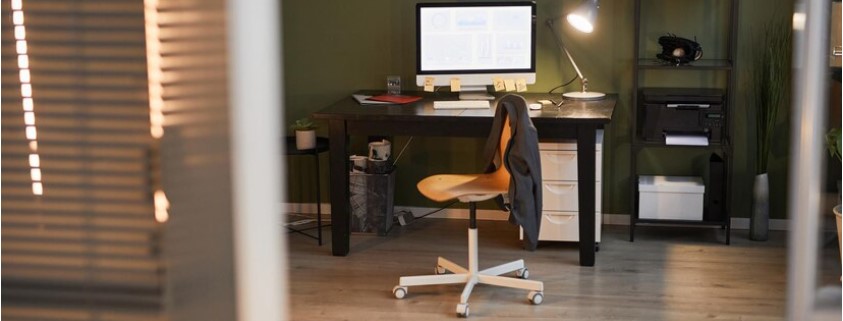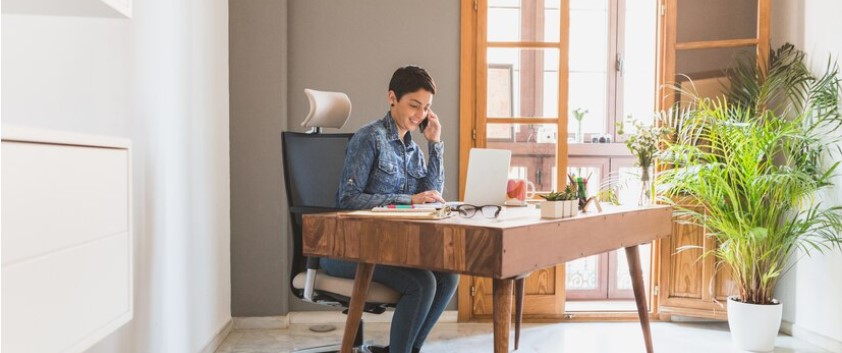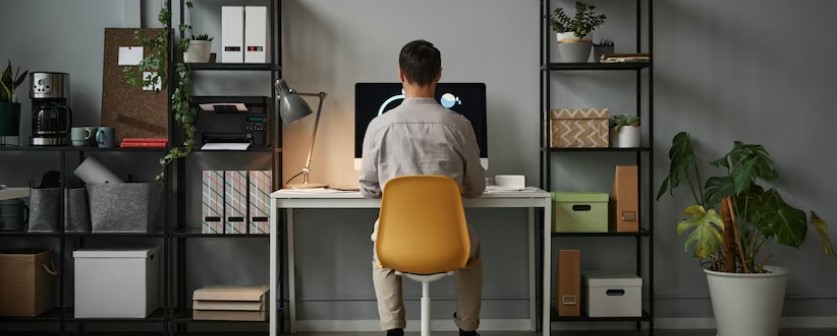In today’s fast-paced world, having a dedicated home office is becoming increasingly important. Whether you’re a freelancer, small business owner, or telecommuting employee, a home office provides you with a quiet and productive space to work from the comfort of your own home.
In this article, we will delve into the importance of having a home office and explore its many benefits. From improving productivity to reducing distractions, we will cover all the key points you need to know about setting up a successful home office. Whether you’re starting from scratch or looking to upgrade your current setup, this article is your ultimate guide to creating a home office that meets your needs and helps you succeed. So, get ready to learn about the many advantages of having a home office and discover how you can create the perfect workspace for your needs.
I. Choosing the Right Space

When it comes to creating a home office, choosing the right space is essential. A well-designed home office can help you be more productive and efficient, while a poorly designed one can lead to distractions and decreased productivity. So, how do you choose the right space for your home office? In this article, we will discuss the importance of natural light, tips for selecting the right room, and ways to make the most of smaller spaces.
A. The Importance of Natural Light:
Natural light is one of the most important factors to consider when choosing the right space for your home office. Not only does natural light help to improve your mood and reduce eye strain, but it also helps to create a bright and inviting workspace. When selecting a room for your home office, look for one with plenty of natural light, or consider adding windows or skylights to bring in more light.
B. Tips for Selecting the Right Room:
When selecting a room for your home office, there are a few key factors to consider. First, think about the size of the room and how much space you will need for your desk, chairs, and other equipment. Second, consider the location of the room and how it will affect your productivity. For example, if the room is near a high-traffic area, it may not be the best choice for a home office. Finally, think about the acoustics of the room and whether it is prone to noise or distractions.
C. Making Use of Smaller Spaces:
If you don’t have a large room to dedicate to your home office, don’t worry! There are many ways to make the most of smaller spaces. For example, you can use a corner of a room, a closet, or even a nook under the stairs. When working with a smaller space, it’s important to be efficient with your furniture and storage solutions. Consider using a compact desk, modular shelving, and other space-saving solutions to maximize your workspace.
In conclusion, choosing the right space for your home office is crucial to your success and productivity. Whether you have a large room or a small nook, by considering factors like natural light, location, and space efficiency, you can create the perfect home office for your needs. So, start exploring your options and find the space that’s right for you!
II. Selecting the Right Furniture

When it comes to setting up your home office, selecting the right furniture is crucial. Not only does it impact the look and feel of your workspace, but it also affects your comfort and productivity. In this article, we will discuss the importance of ergonomics, tips for selecting a desk and chair, and the benefits of standing desks.
A. The Importance of Ergonomics:
Ergonomics refers to the design and arrangement of equipment and furniture to reduce the risk of injury and improve comfort. When selecting furniture for your home office, it’s important to consider ergonomics to ensure that you are comfortable and able to work for long periods of time without experiencing discomfort or pain. Features such as adjustable height, lumbar support, and adjustable armrests can help to reduce the risk of injury and improve your comfort.
B. Tips for Selecting a Desk and Chair:
When selecting a desk and chair for your home office, there are several factors to consider. First, think about the size of the desk and chair and how they fit in the space. Make sure you have enough room to move around and that the desk and chair are proportional to the size of the room. Second, consider the height of the desk and chair and whether they can be adjusted to suit your needs. Finally, think about the material and style of the desk and chair, and choose options that fit your taste and complement your home office decor.
C. Standing Desks and Their Benefits:
Standing desks have become increasingly popular in recent years, and for good reason. They have been shown to improve posture, increase energy levels, and reduce the risk of injury. When choosing a standing desk, look for one that is adjustable so that you can switch between sitting and standing positions throughout the day. Additionally, consider the height and size of the desk, as well as its stability and weight capacity, to ensure that it is the right fit for your needs.
In conclusion, selecting the right furniture for your home office is essential to your comfort, productivity, and overall well-being. By considering factors like ergonomics, desk and chair size, and the benefits of standing desks, you can create a workspace that is comfortable, functional, and stylish. So, start exploring your options and find the furniture that’s right for you!
III. Eliminating Distractions

Distractions can have a significant impact on your productivity, especially when you are working from home. Whether it’s noise, visual distractions, or something else, it’s important to take steps to minimize these distractions and create a more focused and productive workspace.
A. The Importance of Minimizing Noise:
Noise is one of the most common distractions in the workplace, and it can be especially challenging when you are working from home. To minimize noise, it’s important to create a quiet environment that allows you to focus on your work without being disrupted by external sounds. This can include using noise-cancelling headphones, closing windows and doors, and creating designated quiet zones within your home office.
B. Tips for Creating a Quiet Environment:
Creating a quiet environment in your home office starts with understanding the sources of noise in your home. This can include external noise from neighbors, traffic, and nature, as well as internal noise from family members and pets. Once you have identified the sources of noise, you can take steps to minimize them, such as using soundproof curtains, using a white noise machine, and creating designated quiet hours in your home.
C. Dealing with Visual Distractions:
Visual distractions can also be a major problem in the workplace, and it’s important to take steps to minimize these distractions in your home office. This can include clearing clutter, rearranging furniture to reduce visual distractions, and using curtains or blinds to reduce the amount of light entering the room. You can also consider using a privacy screen or using wall organizers to keep your desk clutter-free and focused.
In conclusion, distractions can have a significant impact on your productivity and well-being. By taking steps to minimize noise and visual distractions in your home office, you can create a workspace that is conducive to focus and productivity. So, start exploring your options and find the strategies that work best for you!
IV. Incorporating Plants

Bringing nature into your workspace can have a positive impact on your productivity, mood, and overall well-being. Plants not only add aesthetic appeal to your home office but also provide numerous health benefits, including improved air quality, reduced stress levels, and increased focus. In this article, we will discuss the benefits of having plants in your workspace, tips for choosing plants for your home office, and strategies for caring for indoor plants.
A. The Benefits of Having Plants in Your Workspace:
Having plants in your workspace can have a profound impact on your health and well-being. For example, plants have been shown to improve air quality by removing harmful chemicals from the air, reduce stress levels by promoting a sense of calm, and increase focus and productivity by providing a natural and calming environment. Additionally, having plants in your home office can help you feel more connected to nature and provide a visual break from your computer screen.
B. Tips for Choosing Plants for Your Home Office:
Choosing the right plants for your home office can be a challenge, but it’s important to consider factors like light requirements, humidity levels, and size before making a decision. Some of the best plants for a home office include peace lilies, spider plants, and English ivy, which are all known for their air-purifying abilities and low maintenance requirements. It’s also a good idea to consider your own personal preferences, such as the color, size, and texture of the plants, to ensure you choose plants that you will enjoy looking at and caring for.
C. Caring for Indoor Plants:
Caring for indoor plants is an important part of incorporating them into your workspace. This includes watering the plants regularly, providing adequate light and humidity, and pruning them when necessary. It’s also important to research the specific care requirements of each plant, as some plants may require more attention than others. Regular maintenance and care will ensure that your plants remain healthy and provide you with the maximum benefits they have to offer.
In conclusion, incorporating plants into your home office can have a positive impact on your productivity, mood, and overall well-being. By choosing the right plants, providing proper care, and considering the benefits they provide, you can create a workspace that is both beautiful and functional. So, why not bring a little bit of nature into your home office today?
V. Maximizing Storage

Having a clutter-free and organized workspace is essential for maintaining productivity and focus in your home office. With the rise of remote work and telecommuting, it’s becoming increasingly important for individuals to create a comfortable and functional workspace in their homes. In addition to incorporating plants, which have been shown to have numerous benefits, it’s equally important to choose the right storage solutions.
Tips for Choosing the Right Storage Solutions When choosing storage solutions for your home office, consider the following tips:
- Consider the size of the room and the amount of storage you need. Make sure to choose storage solutions that fit the space and meet your storage needs.
- Look for multi-functional storage solutions. For example, a storage ottoman that doubles as a seat or a bookshelf that also serves as a divider.
- Choose storage solutions that match your décor and style. Your storage solutions should complement the look and feel of your home office.
Creative Storage Solutions for Smaller Spaces For those working with limited space, creative storage solutions can help maximize the area and keep the workspace organized. Here are a few ideas to consider:
- Use vertical space. Consider purchasing a tall bookshelf or hanging baskets on the wall to store items.
- Utilize under-desk storage. Slide-out drawers or baskets that fit under your desk can be a great way to store items and keep the area clutter-free.
- Consider furniture with built-in storage. For example, a desk with drawers or a chair with a built-in bookshelf.
Organizing and Decluttering Tips To keep your home office organized and clutter-free, it’s important to develop good habits and regularly declutter. Here are some tips to get started:
- Set aside time each week to go through your workspace and remove any items that are no longer needed.
- Implement a “one in, one out” rule. Before bringing in new items, make sure to get rid of something that’s no longer needed.
- Keep frequently used items within reach. Having items that you use daily within easy reach will help minimize the amount of clutter on your desk and in your drawers.
By incorporating the right storage solutions and adopting good organizing habits, you can create a clutter-free and functional workspace that supports your productivity and wellbeing.
VI. Creating a Comfortable Environment

Having a home office can be a blessing and a curse. On one hand, you get the freedom and flexibility to work in your own space. On the other hand, you need to create an environment that is both productive and comfortable. This is where temperature control comes in. A comfortable environment is key to staying focused, motivated, and productive throughout the day.
A. The Importance of Temperature Control
Maintaining a comfortable temperature is essential for staying focused and motivated in your home office. If it’s too hot, you’ll feel sluggish and irritable. If it’s too cold, you’ll be shivering and unable to concentrate. A comfortable temperature will help you feel more alert and refreshed, enabling you to get more done in less time.
B. Tips for Creating a Comfortable Environment
There are several steps you can take to create a comfortable environment in your home office. Start by adjusting the temperature to a level that feels good to you. You can also use fans or heaters to regulate the temperature as needed. Additionally, make sure your office is well-ventilated so that air can circulate freely.
C. Using Scents and Lighting to Enhance Mood
Another way to create a comfortable environment is to use scents and lighting. Certain scents, such as lavender, lemon, or peppermint, can help you feel more relaxed and focused. You can use essential oils, candles, or diffusers to create a soothing atmosphere. Additionally, lighting can also play a big role in your mood and productivity. Opt for natural light whenever possible, and use lamps or artificial lights to provide additional illumination when needed.
In conclusion, by incorporating temperature control, scents, and lighting into your home office, you can create a comfortable environment that will help you stay focused and motivated throughout the day. So, don’t be afraid to experiment and find what works best for you.
Conclusion
In conclusion, it’s essential to create a comfortable and functional home office space that enhances productivity and well-being. By incorporating the right furniture, reducing distractions, and adding elements such as natural light, plants, and a controlled temperature, you can create an environment that meets your needs.
This article has provided you with a summary of the key points and tips to help you design the ideal home office space. Remember, the ultimate goal is to create a workspace that you enjoy spending time in, so don’t be afraid to personalize it to suit your preferences. Encouragement to create an ideal home office space is essential, so take the time to invest in yourself and create a space that works for you.



